Customise your DualSense Edge wireless controller
What you can customise
What's on the screen
Create and edit profiles
Switch profiles
Configure controller settings
Use PlayStation Accessories
![]() to edit your profiles on your Windows PC. If you don't have the app installed yet, see PlayStation®Accessories for instructions on installing. Make sure to also update the controller firmware to the latest version.
to edit your profiles on your Windows PC. If you don't have the app installed yet, see PlayStation®Accessories for instructions on installing. Make sure to also update the controller firmware to the latest version.
What you can customise
You can customise button and stick settings for your DualSense Edge™ wireless controller, and then save the settings to a custom profile. You can use custom profiles in the following ways:
- Use shortcuts to switch profiles
Including the default profile, you can save up to four profiles on your controller. Use shortcuts to quickly switch profiles during gameplay. - Use saved profiles on another device
Profiles are saved in your controller. As long as you use your controller, you can access your own profiles to play with the settings you're accustomed to, even on another computer or mobile device.
You can save the following settings to your profiles.
You can also customise your controller by changing parts such as back buttons and stick caps. For details about included parts and how to replace them, check the instruction manual included with your controller
Button Assignments
You can change the functions assigned to buttons. Select the button to see the functions that can be assigned.. DualSense Edge wireless controller part names

Stick Sensitivity/Deadzone
You can adjust the sensitivity and deadzone of the sticks on your controller. Here are some examples of what you can do:
- Adjust the stick sensitivity to speed up or slow down your character's movement or view.
- Set the deadzone to have finer control over your character's movement or view.
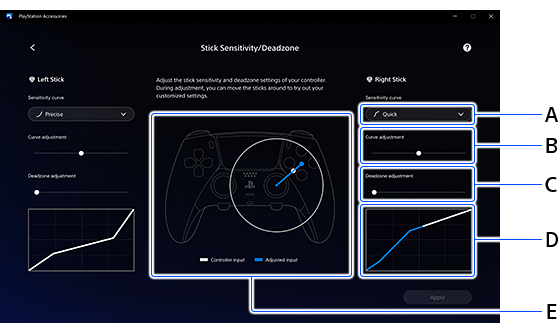
A to D uses the right stick as an example. You can set up your left stick in the same way.
- A )
-
Sensitivity curve
Choose from six types of sensitivity curves. Default
DefaultThe registered input increases in proportion to the movement of the stick.  Quick
QuickThe amount of registered input accelerates as you tilt the stick. Good for making quick movements.Gain the upper hand by quickly aiming in fast-paced shooting games.  Precise
PreciseMinimum input is registered when you tilt the stick. Good for making precise movements.
Fans of shooting games may find the ability to aim slowly and accurately helpful. Steady
SteadyRegistered input is limited even if you tilt the stick far. Enables smooth and stable movement.  Digital
DigitalTilting the stick even slightly registers nearly maximum input. Functions like the directional buttons on the controller.
Get instant input reaction for your fighting and action games. Dynamic
DynamicRegistered input is limited when you tilt the stick slightly or far, but accelerates in the middle range.
Enables versatile gameplay in shooting games, where you not only need to aim carefully, but also turn quickly. - B )
- Curve adjustment
Fine-tune the curve type you chose in A. - C )
- Deadzone adjustment
Deadzone is the range that you can tilt the stick before it's recognised as an input. For example, with a deadzone of 10% you need to exceed a tilt of 10% before your game registers an input. - D )
-
Curve
The horizontal axis is the stick tilt and the vertical axis is the input reflected in game. For example, when there's a gradual slope, greatly titling the stick results in smooth movement. When there's a steep slope, tilting the stick even slightly results in fast movement. - E )
- Test your controller
See the sensitivity when you move the stick.
Trigger Deadzone
Deadzone is the range that you can press a button before it's recognised as an input. For example, when you're gripping your controller tightly and accidentally tap the L2 or R2 buttons, you can set it so that no input is registered.

- A )
- Apply same settings for left and right triggers
When turned on, only one side is displayed. Changes you make affect both left and right triggers equally. - B )
- Input range
Set the range that you have to press the trigger for your game to register an input.
For example, if you set the input range from 30 to 70, pressing the trigger deeper than 30 starts to register an input in your game. Input reaches a maximum depth of 70. Pressing the trigger shallower than 30 or deeper than 70 doesn't register an input. - C )
- Test your controller
See the input range when you press the L2 and R2 buttons.
Vibration/Trigger Effect Intensity
You can adjust your controller's vibration and trigger effect intensity, or turn them off.
The trigger effect feature lets you feel varying levels of tension and resistance from the L2 and R2 buttons in response to your gameplay. For example, you can feel a strong resistance when you forcefully draw back a bow and arrow or abruptly apply the brakes in a game.
- You can experience the trigger effect only in games that support it.
- Depending on your trigger deadzone settings, the trigger effect function may not work.
You can set how far the L2 button and R2 button go when you press them (stroke) using the L2/R2 stop sliders on the rear of your controller. Starting from the top, you can set the stroke to long stroke, medium stroke, and short stroke.
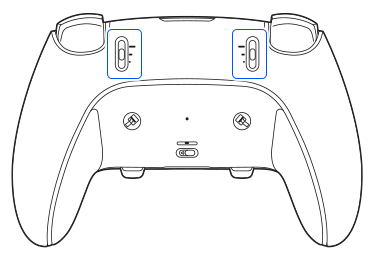
If you set the L2 and R2 stop sliders to medium or short strokes, the trigger effect function doesn't work.
What's on the screen
After launching PlayStation Accessories
![]() , your controller connects, and you see the following screen.
, your controller connects, and you see the following screen.
Use a mouse or keyboard to operate the app.

- A )
- Connected controllers
You can connect up to four controllers at the same time. - B )
- Controller number
Controller numbers are assigned to users in the order that they connect. You can also check the player indicator for the controller number. DualSense Edge wireless controller part names - C )
- Controller battery level
- D )
- Controller Settings
Configure controller feedback settings, reset all settings, and more. Configure controller settings - E )
- App-related information
Check information about the version of your app, manage data collection settings, and more.
Select Help to go to this website. - F )
- Firmware for your controller
Check your current firmware version. When a new version is available, Update appears.
Do not turn off your Windows PC or disconnect your controller during the update for your controller. If you're updating multiple controllers, you need to update one controller at a time. - G )
- Profile list
See a list of the profiles you created. The profile you're using now is marked with Currently applied .
.
Create Profile is shown if there are no existing profiles. Create and edit profiles
You can check your controller's connection method by selecting Add Controller.
Create and edit profiles
Create a new profile
Edit a profile you created
Create a new profile
- 1.
-
Select Create Profile, or select a profile marked Not assigned from the profile list.
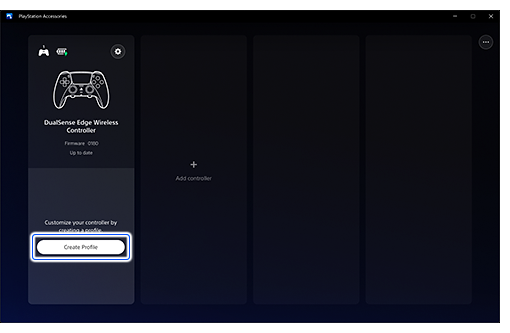
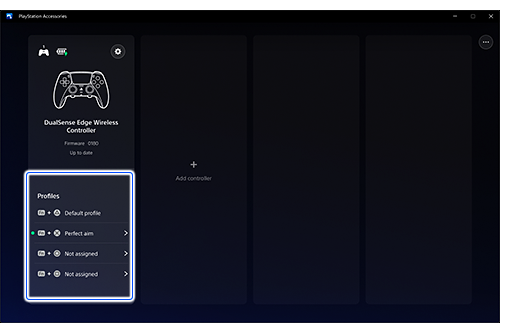
- 2.
- Enter the name of your profile, and then select Next.
- 3.
-
Select a shortcut to assign your profile to, and then select Create Profile.
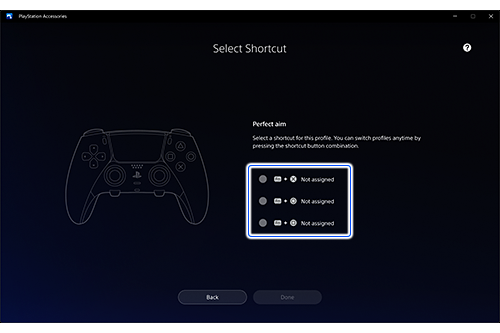
- 4.
- Select from the settings on the screen to begin customising your profile.
For what settings you can customise with each item, see What you can customise.After customising each item, select Apply. If you return to the previous screen without doing so, your changes aren't saved.
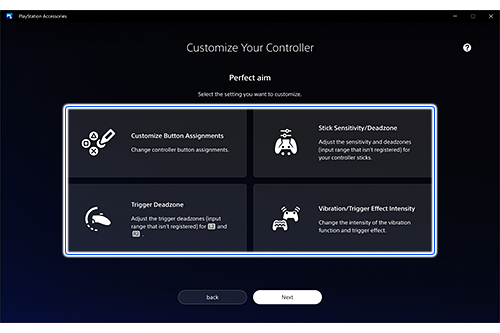
- 5.
- When you're finished customising the items that you want, select Done.
To use a profile you created, press and hold both buttons of the shortcut you selected in step 3 (a combination of Fn button and  button/
button/ button/
button/ button). Switch profiles
button). Switch profiles
- The Default profile is assigned to the Fn button and
 button. To use your controller at factory settings, select the Default profile.
button. To use your controller at factory settings, select the Default profile. - You can assign up to three profiles to your controller. This doesn't include the Default profile.
Edit a profile you created
- 1.
-
Select the profile you want to edit.

- 2.
-
Select Edit.
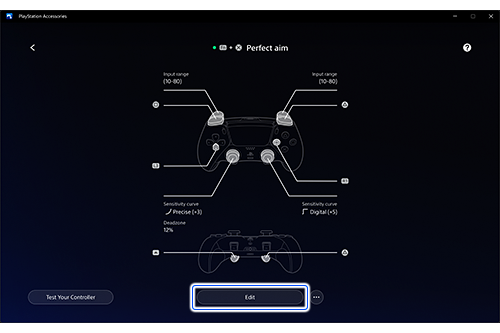
- If you select Test Your Controller, you can use the sticks and the L2 button/R2 button to test the sensitivity and input range of your controller.
- You can't edit or delete the Default profile.
Switch profiles
During gameplay, press and hold the Fn button, and then press the  button/
button/ button/
button/ button/
button/ button to switch to the corresponding profile. DualSense Edge wireless controller part names
button to switch to the corresponding profile. DualSense Edge wireless controller part names
If you switch profiles, your controller vibrates, and the player indicator flashes the following number of times.
Fn button and  button button |
One |
|---|---|
Fn button and  button button |
Two |
Fn button and  button button |
Three |
Fn button and  button button |
Four |
You can change what your controller does when switching profiles in Controller Settings.
Configure controller settings
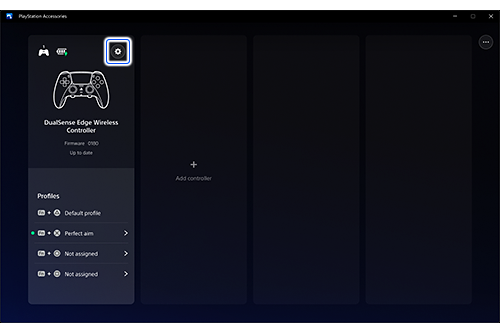
When you select Controller Settings
![]() , you can do the following things:
, you can do the following things:
| Receive Feedback When Switching Profiles | Set your controller to vibrate or light up when you switch profiles. Switch profiles |
|---|---|
| Brightness of Controller Indicators | Set the brightness of the player indicator and the light bar on your controller. DualSense Edge wireless controller part names |
| Take the Tour | See the welcome screen from when you first connected your DualSense Edge wireless controller. |
| Reset Your DualSense Edge Wireless Controller | All your profiles are deleted, all settings are reset, and your controller returns to factory settings. |
